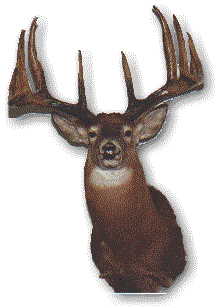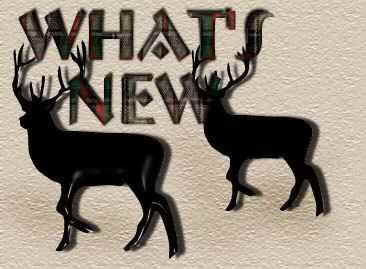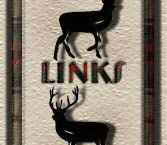






Latest Reseach
The first topic I would like to talk to you about is Angiogenesis - that is the growth of blood vessels. As you all know deer velvet grows at up to 2cm per day. This means that all support tissues, including blood vessels must also grow at that rate. The question is how can they do this? Is it possible that deer velvet possesses unique factors which can allow blood vessels to grow that fast - and if so how can we exploit this knowledge?
One way of showing that a substance causes blood vessel
growth is to test it on fertilised chickens's eggs. As the chicken embryo
develops in the egg, blood vessels grow out and surround the egg white.
It is possible to treat small areas with test substances; those that reduce
blood vessel growth will leave a space, those that stimulate blood vessel
growth will cause an increase in the density of blood vessels. On the
left of the screen there is a control - you can see some blood vessels
and on the right there is a treated egg. This egg was actually treated
with purified growth factors, but deer velvet operates in exactly the
same way. You can see the increase in the number of blood vessels."
A second way of showing that deer velvet causes blood vessels
to grow is to take small pieces of adult deer arteries and put them in
tissue culture. You can then add test substances and see if they cause
outgrowths. In this figure we have taken a small slice of deer carotida
artery and treated it with deer velvet extract. You can clearly see filamentous
threads of new blood vessels growing out from the artery. This means that
the deer velvet extract causes new blood vessels to grow.
Taking these results together it is clear that there are
factors in deer velvet which promote blood vessel growth. There are likely
to be therapeutic properties, for example in tissue repair and wound healing
which are being actively pursued.
Deer velvet is unique in that it is the only mammalian organ
to fully regenerate each year. It follows that there are likely to be
unique factors which are responsible for this property.
We have developed a system to identify genes which are only expressed
- that is, make proteins - in antler. This slide shows 3 genes which are
clearly present in the antler and not in the deer body - the rather smudgy
bands indicate the gene is working in antler and not body tissue. The
need now is to find out what these genes are doing, and is the function
novel and commercially exploitable. Function is the key for a patentable
finding.
We can use a number of techniques to help us determine function.
This figure shows, on the right, a piece of velvet under the microscope
and on the left the same piece of velvet which has been treated to show
that a gene of interest is present. The lighter areas, which are around
blood vessels, indicate that this gene probably is involved with blood
vessel growth. We know of other genes which are found only around new
bone synthesis. Such information gives clues as to function. No single
technique can answer all the questions and we need a set of techniques
to be sure of novel function.
So we can conclude that there are novel factors in deer velvet, which we can find, which are not present elsewhere in the body. These factors could be markers for deer velvet in dietary supplements or be novel action ingredients for new supplements.
One possible safety risk that we have been aware of for
some time is that deer velvet could either speed up the growth of an existing
tumour, conversely it could possibly prevent a tumour from establishing.
We have researched these possibilities with colleagues at the University
of Otago. Preliminary data just to hand indicates that deer velvet does
not worsen existing tumours, nor prevent the incidence of tumours in rats.
The effects on tumour growth rate are still being analysed. This overall
is a positive finding as a risk to the consumption of deer velvet can
be discounted.
Deer velvet may contain a liver protecting factor, and indeed some recently
released Canadian data points to this. We have looked at whether NZ deer
velvet is effective by measuring the levels of liver enzymes which are
raised when the liver is damaged. We also had the opportunity to look
at the effect of deer velvet processing techniques on liver protecting
factors.
The data shows that for 2 liver enzymes, AST and AL T, levels were lower
- indication of less damage - in animals fed deer velvet compared to controls.
The freeze dried deer velvet appeared slightly better than heat processed
deer velvet in this respect.
We can conclude that, in this model NZ deer velvet exerted a liver protection
effect.
So in terms of science achievement we have new results in 4 key areas.
Some further recent
references
Toxicological evaluation of New Zealand
deer velvet powder. Part I: acute
and subchronic oral toxicity studies in rats.
Zhang-H; Wanwimolruk-S; Coville-PF; Schofield-JC; Williams-G;
Haines-SR;
Suttie-JM
Food-and-Chemical-Toxicology. 2000, 38: 11, 985-990; 13 ref.
Potential toxic effects of acute and subchronic dosage
regimens of deer
velvet powder have been assessed in rats following OECD guidelines. In
the
acute study, rats of both sexes were exposed to a single dose of 2 g/kg
body weight. There was no mortality or other signs of toxicity during
14
days' observation. Furthermore, no significant alteration either in
relative organ weights or their histology was discernible at terminal
autopsy. In the 90-day subchronic study, deer velvet was administered
in 1
g/kg daily doses by gavage to rats. A control group of rats received water
only. There was no effect on body weight, food consumption, clinical
signs, haematology and most parameters of blood chemistry including
carbohydrate metabolism, liver and kidney function. No significant
differences were seen between the mean organ weights of the adrenal,
kidney and brain in rats treated with deer velvet and control rats.
However, there was a significant difference (P < 0.05)
in the group mean
relative liver weight (3.52±0.30 vs 3.81±0.26 g/100 g body
weight) of deer
velvet-treated and control male rats. The gross necropsy and pathological
examination of rats treated with deer velvet did not reveal any
abnormalities in tissue morphology. Based on these results, it may be
concluded that rats had no deer velvet treatment-related toxicological
and
histopathological abnormalities at the doses administered, despite the
observed minor changes in liver weight.
Cells in regenerating deer antler cartilage provide a
microenvironment that
supports osteoclast differentiation.
Faucheux-C; Nesbitt-SA; Horton-MA; Price-JS
Journal-of-Experimental-Biology. 2001, 204: 3, 443-455; Many ref.
Lysophosphatidylcholine derived from deer antler extract
suppresses hyphal
transition in Candida albicans through MAP kinase pathway.
Min-Juyoung; Lee-YounJin; Kim-YoungAh; Park-HyunSook; Han-SoYeop;
Jhon
-GilJa; Choi-Wonja; Min-J; Lee-YJ; Kim-YA; Park-HS; Han-SY; Jhon-GJ; Choi-W
Biochimica-et-Biophysica-Acta,-Molecular-and-Cell-Biology-of-Lipids.
2001,
1531: 1-2, 77-89; 35 ref.
A family of 2-lysophosphatidylcholines (lyso-PCs) was isolated
from deer
antler extract, guided exclusively by hyphal transition inhibitory
activity in Candida albicans. Structural determination of the isolated
lyso-PCs by spectroscopic methods, including infrared spectroscopy, 1H
nuclear magnetic resonance (NMR), 13C NMR, 2D correlation spectroscopy
NMR, fast atom bombardment mass spectrometry and tandem mass spectrometry,
confirmed that the natural products were composed of at least 4 different
lyso-PCs varying in fatty acid moiety at the sn-1 position of the glycerol
backbone.
The major lyso-PCs were confirmed as 1-stearoyl-, 1-oleoyl-,
1
-linoleoyl- and 1-palmitoyl-2-lyso-sn-glycero-3-phosphatidylcholines.
Lyso
-PC specifically suppressed the morphogenic transition from yeast to
hyphae in C. albicans, without affecting the growth of either yeast or
hyphae. Lyso-PC exerted hyphal transition that suppressed activity in
the
broad spectrum of the Candida species, such as C. albicans, C. krusei,
C.
guilliermondii and C. parapsilosis. Northern analysis indicated that the
suppression was mediated through the mitogen-activated protein kinase
pathway.
Concentrations of insulin-like growth factor-I in adult
male white-tailed
deer (Odocoileus virginianus): associations with serum testosterone,
morphometrics and age during and after the breeding season.
Ditchkoff-SS; Spicer-LJ; Masters-RE; Lochmiller-RL
Comparative-Biochemistry-and-Physiology.-A,-Molecular-and-Integrative
-Physiology. 2001, 129: 4, 887-895; 57 ref.
Our understanding of insulin-like growth factor-I (IGF-I)
in cervids has
been limited mostly to its effects on antler development in red deer
(Cervus elaphus), roe deer (Capreolus capreolus), fallow deer (Dama dama),
and pudu (Pudu puda). Although IGF-I has been found to play a critical
role in reproductive function of other mammals, its role in reproduction
of deer is unknown. The objectives of the present study were to determine
if serum levels of IGF-I change during the breeding season, assess whether
age influences serum IGF-I, compare levels of IGF-I measured during and
following the breeding season, and determine if IGF-I is associated with
body and antler characteristics in free-ranging adult, male white-tailed
deer (Odocoileus virginianus). We collected serum and morphometric data
from hunter-harvested and captured white-tailed deer to investigate these
objectives. Mean level of serum IGF-I during the breeding season was 63.6
ng/ml and was greatest in deer between 2.5 and 5.5 years old (57.4-79.9
ng/ml). Levels of serum IGF-I decreased by approximately 40% as the
breeding season progressed, but levels were less in deer following the
breeding season (34.6 ng/ml). Both body and antler size were associated
positively with IGF-I when controlling for age. Serum testosterone was
also associated positively with IGF-I. Levels of serum testosterone during
the breeding season generally increased with age from 4.82 (1.5 years
old)
to 18.79 ng/dl (5.5 years old), but decreased thereafter. These data
suggest that IGF-I may be an important hormone in breeding, male white
-tailed deer.
Potential uses of velvet antler as nutraceuticals, functional
and medical
foods in the West.
Sunwoo-HH; Sim-JS
Journal-of-Nutraceuticals,-Functional-and-Medical-Foods.
2000, 2: 3, 5-23;
38 ref.
Velvet antlers have been used as Oriental medicine for many
centuries.
Traditional medical reports and clinical observations from the Eastern
world convincingly show that velvet antler is biologically active.
However, little information is available on chemical and biological
efficacy of antler products in the West due to the incomplete
understanding of the uses and pharmacological properties of velvet
antlers. To make antler products acceptable as nutraceuticals and
functional foods in the West, antler research has been conducted to
isolate and characterize the chemical and biological properties of velvet
antlers. The chemical composition of antler was determined in four
sections (tip, upper, middle, and base). Contents of dry matter, collagen,
ash, calcium, phosphorus, and magnesium increased (P<0.05), and those
of
protein and lipid decreased (P<0.05) downward from the tip to the base.
The concentrations of uronic acid, sulfated glycosaminoglycan
(GAG), and
sialic acid decreased (P<0.05) downward. Amino acid and fatty acid
contents, expressed as percentage of total protein and lipid,
respectively, also varied (P<0.05) among sections. The yield of
chondroitin sulfate (CS) was approximately six fold greater in the
cartilaginous (tip and upper) sections than in the bony (middle and base)
sections. In addition to CS, the antler sections contained small amounts
of keratan sulfate (KS), hyaluronic acid, and dermatan sulfate. Two
proteoglycans associated with GAGs were also extracted from the
cartilaginous section; a large aggregated proteoglycan with CS and KS
and
small molecules of decorin. Water soluble extracts rich in GAG stimulated
the growth of bovine fibroblast in culture. Feeding antler diet for 54
days showed a significant effect on the growth rate of immunized rats.
Diet antler powder resulted in a significant increase of HDL-C/LDL-C ratio
(P<0.05). The result appears to reflect the involvement of unknown
factor(s) derived from the antler diet suggesting the importance for the
prevention of the risk of coronary heart disease. Haematocrit value and
iron content in plasma also significantly increased by feeding antler
powder (P<0.05). The data suggest that there are significant unknown
factor(s) in the antler powder that enhances the biological performance
of
growing rats.
Effects of insulin-like growth factor 1 and testosterone
on the
proliferation of antlerogenic cells in vitro.
Li-ChunYi; Littlejohn-RP; Suttie-JM; Li-CY
Journal-of-Experimental-Zoology. 1999, 284: 1, 82-90; 27 ref.
The aim of this study was to use cell culture techniques
to investigate how
testosterone and IGF1 affects the proliferation of antlerogenic cells
from
the four ossification stages of pedicle/antler in vitro. The results
showed that in serum-free medium IGF1 stimulated the proliferation of
antlerogenic cells from all four ossification stages (intramembraneous
(IMO), transistional (OPC), pedicle endrochondral (pECO) and antler
enfochondral (aECO)) in a dose-dependent manner. In contrast, testosterone
alone did not show any mitogenic effects on these antlerogenic cells.
However, in the presence of IGF1, testosterone increased
proliferation of
the antlerogenic cells from the IMO and the OPC stages (pedicle tissue),
and reduced proliferation of the antlerogenic cells from transformation
point (TP) and aECO stages (antler tissue). Therefore, the results from
the present in vitro study support the in vivo findings that androgen
hormones stimulate pedicle formation but inhibit antler growth. The change
in the mitogenic effects of testosterone on antlerogenic cells from
positive to negative occurs approximately at the change in ossification
type from OPC to pECO. Therefore, these results reinforce the hypothesis
that the transformation from a pedicle to an antler takes place at the
time when the ossification type changes from OPC to pECO rather than at
the time when the pedicle grows to its full species-specific height.
Seasonal changes of testis volume, scrotal circumference and serum
testosterone concentrations in male sika deer (Cervus nippon).
Kameyama-Y; Takahashi-R; Ito-M; Maru-R; Ishijima-Y
Animal-Science-Journal. 2000, 71: 2, 137-142; 23 ref.
Annual changes in the concentration of serum testosterone
(T) in sika deer
stags were examined. The relationships between T concentration and the
size of testis, and between T concentration and the antler cycle were
also
evaluated. T concentration increased between July and September, then
decreased between October and November. The highest T concentration was
noted in September or October. During the period from November to the
following July, T concentration remained low. The volume of the testis
and
scrotal circumference showed changes similar to those in the T
concentration. The testis volume showed clearer seasonal changes than
those of the scrotal circumference. Shedding of velvets was observed
during the period of high T concentrations. It is concluded that there
are
distinct annual changes in the blood T concentration in sika deer stags,
which are related to the annual changes in testis volumes, scrotal
circumferences and antlers.
Antinarcotic effects of the velvet antler water extract on morphine in mice.
Kim-HackSeang; Lim-HwaKyung; Park-WooKyu; Kim-HS; Lim-HK; Park-WK
Journal-of-Ethnopharmacology. 1999, 66: 1, 41-49; 35 ref.
The present study was undertaken to investigate the antinarcotic
effects of
velvet antler water extract (VAWE) from Cervus elaphus on morphine in
mice. Morphine-induced analgesic action was measured by the tail-flick
method. Morphine-induced hyperactivity and reverse tolerance were
evidenced by measuring the enhanced ambulatory activity using a tilting
-type ambulometer. Dopamine (DA) receptor supersensitivity in mice
displaying morphine-induced reverse tolerance was evidenced by the
enhanced response in ambulatory activity to the DA agonist, apomorphine.
The repeated administration of VAWE significantly inhibited the
development of morphine-induced analgesic tolerance, physical dependence,
reverse tolerance and postsynaptic DA receptor supersensitivity. But a
single administration of VAWE neither antagonized morphine-induced
analgesia nor inhibited morphine-induced hyperactivity. From the above
results, it is presumed that VAWE may be useful for prevention and therapy
of the adverse actions of morphine caused by the repeated administration
of morphine.
Effect of water-soluble extract from antler of wapiti
(Cervus elaphus) on
the growth of fibroblasts.
Sunwoo-HH; Nakano-T; Sim-JS
Canadian-Journal-of-Animal-Science. 1997, 77: 2, 343-345; 7 ref.
Water-soluble extracts were prepared from the tip sections
of antlers of 4
-year-old wapiti stags, and the effect of the extract on the growth of
bovine skin fibroblasts in culture was examined. The results showed the
presence of growth promoting factor(s) in the antler extract. The
stimulation of cell growth was found to be dose-dependent (P<0.05).
Glycosaminoglycans from growing antlers of wapiti (Cervus
elaphus).
Sunwoo-HH; Sim-LYM; Nakano-T; Hudson-RJ; Sim-JS
Canadian-Journal-of-Animal-Science. 1997, 77: 4, 715-721; 33 ref.
The emerging wapiti industry in North America is based largely
on markets
for velvet antlers which are used in oriental medicine. Despite the
economic opportunity, enthusiasm has been dampened by incomplete
understanding of the chemical and pharmacological properties of velvet
antler. This study characterizes polysaccharide constituents of
glycosaminoglycans in growing antler of wapiti (Cervus elaphus).
Glycosaminoglycans were isolated from four sections (tip, upper, middle
and base) of growing antlers, and were studied using cellulose acetate
electrophoresis, gel electrophoresis, enzymic digestion and gel
chromatography. The tip and upper sections of the antler which are rich
in
cartilaginous tissues contained chondroitin sulfate as a major
glycosaminoglycan with small amounts of hyaluronic acid. In the middle
and
base sections containing bone and bone marrow, chondroitin sulfate was
also a major glycosaminoglycan with small amounts of hyaluronic acid and
chondroitinase-ACI resistant materials. More than half of chondroitin
sulfate from the middle and base sections had larger molecular size than
did the chondroitin sulfates from the tip and upper sections.
To Purchase Deer Velvet Antler Click Here
News Articles
Links
- Articles /Research on Deer Velvet Antler
- Deer Velvet Antler Books, Magazines and Journals
- Deer/Elk Associations and Sites
- Alternative Medicine
- Natural Health Stores
Pictures
To Purchase Deer Velvet Antler Click Here

